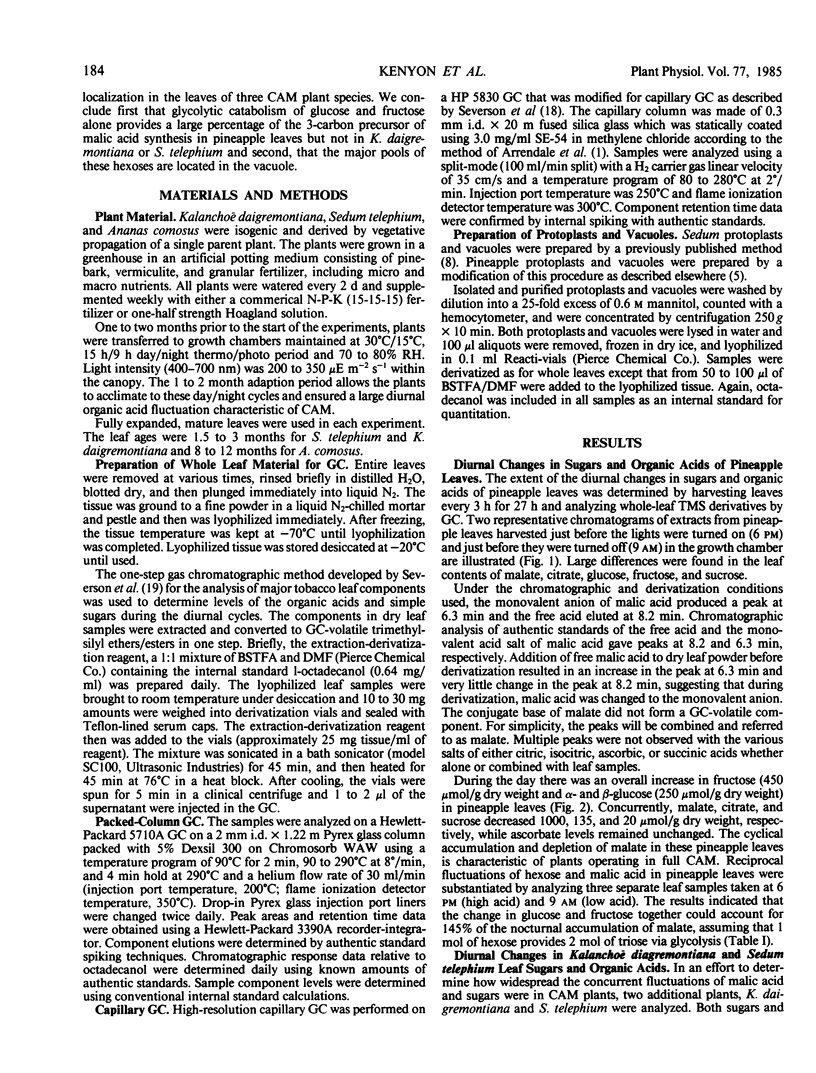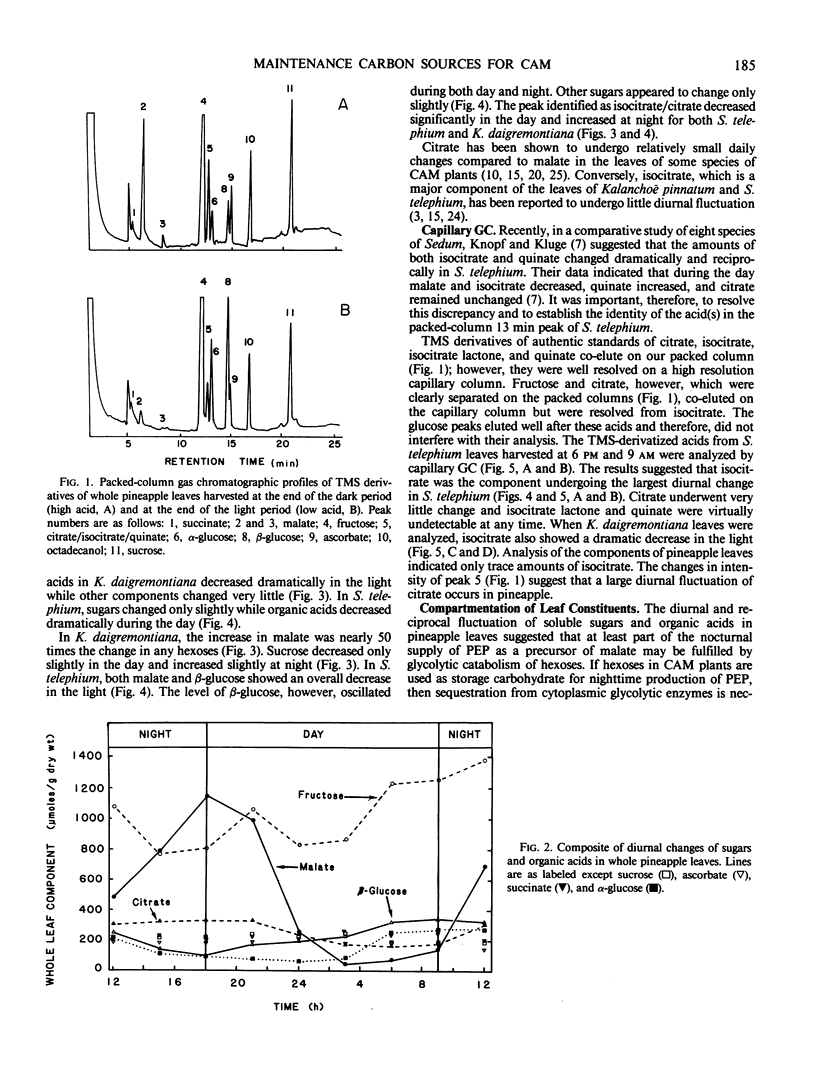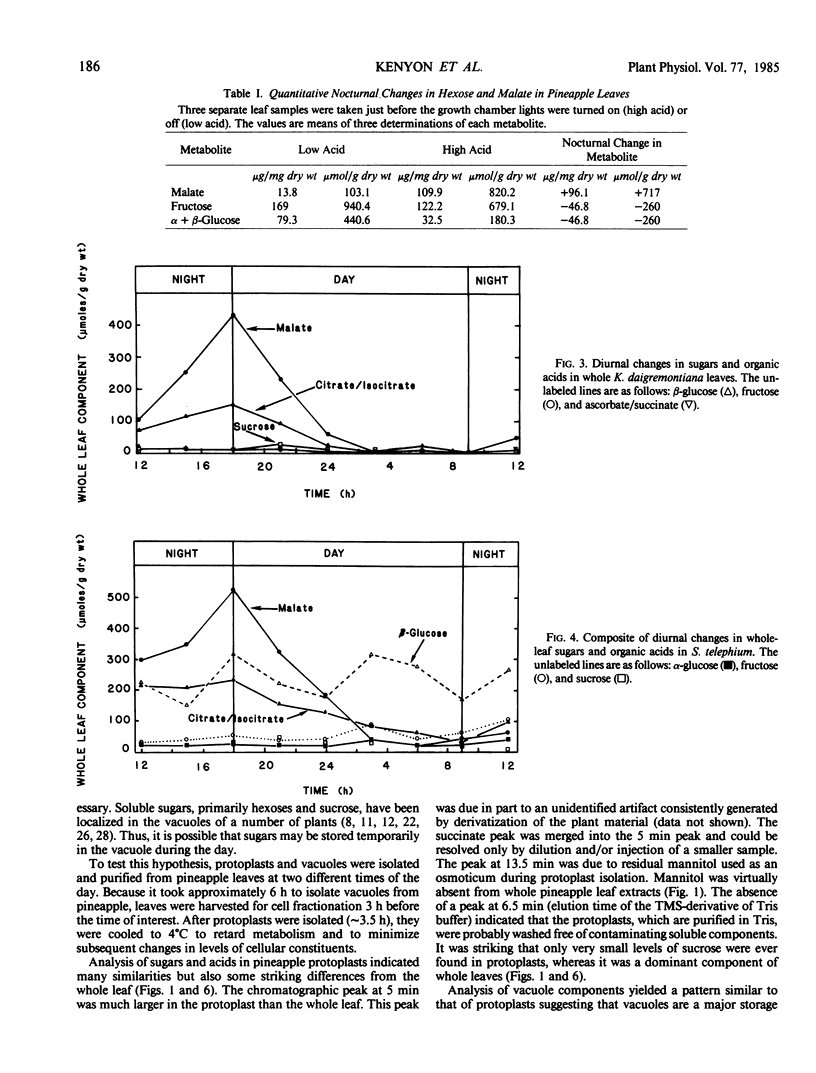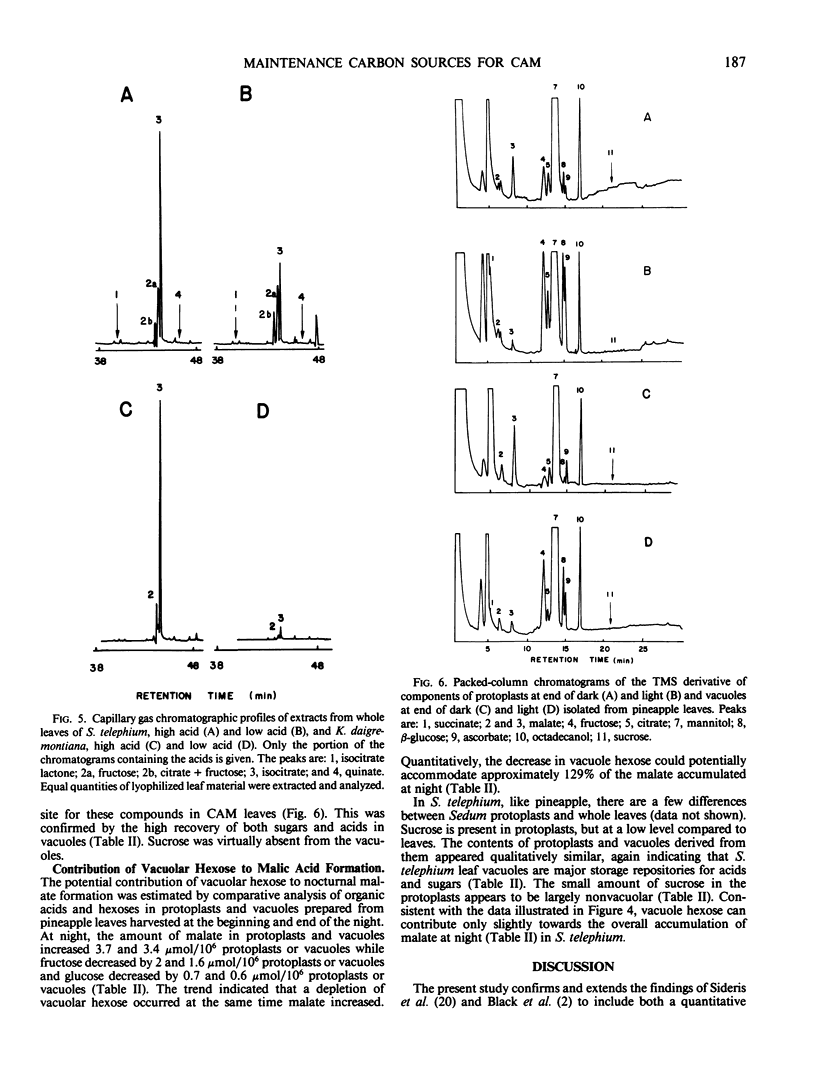Abstract
The reciprocal relationship between diurnal changes in organic acid and storage carbohydrate was examined in the leaves of three Crassulacean acid metabolism plants. It was found that depletion of leaf hexoses at night was sufficient to account quantitatively for increase in malate in Ananas comosus but not in Sedum telephium or Kalanchoë daigremontiana. Fructose and to a lesser extent glucose underwent the largest changes. Glucose levels in S. telephium leaves oscillated diurnally but were not reciprocally related to malate fluctuations.
Analysis of isolated protoplasts and vacuoles from leaves of A. comosus and S. telephium revealed that vacuoles contain a large percentage (>50%) of the protoplast glucose, fructose and malate, citrate, isocitrate, ascorbate and succinate. Sucrose, a major constituent of intact leaves, was not detectable or was at extremely low levels in protoplasts and vacuoles from both plants.
In isolated vacuoles from both A. comosus and S. telephium, hexose levels decreased at night at the same time malate increased. Only in A. comosus, however, could hexose metabolism account for a significant amount of the nocturnal increase in malate. We conclude that, in A. comosus, soluble sugars are part of the daily maintenance carbon cycle and that the vacuole plays a dynamic role in the diurnal carbon assimilation cycle of this Crassulacean acid metabolism plant.
Full text
PDF






Selected References
These references are in PubMed. This may not be the complete list of references from this article.
- Kenyon W. H., Holaday A. S., Black C. C. Diurnal Changes in Metabolite Levels and Crassulacean Acid Metabolism in Kalanchoë daigremontiana Leaves. Plant Physiol. 1981 Nov;68(5):1002–1007. doi: 10.1104/pp.68.5.1002. [DOI] [PMC free article] [PubMed] [Google Scholar]
- Kringstad R., Kenyon W. H., Black C. C. The rapid isolation of vacuoles from leaves of crassulacean Acid metabolism plants. Plant Physiol. 1980 Sep;66(3):379–382. doi: 10.1104/pp.66.3.379. [DOI] [PMC free article] [PubMed] [Google Scholar]
- Leigh R. A., Rees T., Fuller W. A., Banfield J. The location of acid invertase activity and sucrose in the vacuoles of storage roots of beetroot (Beta vulgaris). Biochem J. 1979 Mar 15;178(3):539–547. doi: 10.1042/bj1780539. [DOI] [PMC free article] [PubMed] [Google Scholar]
- Moskowitz A. H., Hrazdina G. Vacuolar contents of fruit subepidermal cells from vitis species. Plant Physiol. 1981 Sep;68(3):686–692. doi: 10.1104/pp.68.3.686. [DOI] [PMC free article] [PubMed] [Google Scholar]
- Nishimura M., Beevers H. Hydrolases in vacuoles from castor bean endosperm. Plant Physiol. 1978 Jul;62(1):44–48. doi: 10.1104/pp.62.1.44. [DOI] [PMC free article] [PubMed] [Google Scholar]
- Pucher G. W., Vickery H. B., Abrahams M. D., Leavenworth C. S. STUDIES IN THE METABOLISM OF CRASSULACEAN PLANTS: DIURNAL VARIATION OF ORGANIC ACIDS AND STARCH IN EXCISED LEAVES OF BRYOPHYLLUM CALYCINUM. Plant Physiol. 1949 Oct;24(4):610–620. doi: 10.1104/pp.24.4.610. [DOI] [PMC free article] [PubMed] [Google Scholar]
- Saltman P., Lynch V. H., Kunitake G. M., Stitt C., Spolter H. The Dark Fixation of CO(2) by Succulent Leaves: Metabolic Changes Subsequent to Initial Fixation. Plant Physiol. 1957 May;32(3):197–200. doi: 10.1104/pp.32.3.197. [DOI] [PMC free article] [PubMed] [Google Scholar]
- Sideris C. P., Young H. Y., Chun H. H. DIURNAL CHANGES AND GROWTH RATES AS ASSOCIATED WITH ASCORBIC ACID, TITRATABLE ACIDITY, CARBOHYDRATE AND NITROGENOUS FRACTIONS IN THE LEAVES OF ANANAS COMOSUS (L.) MERR. Plant Physiol. 1948 Jan;23(1):38–69. doi: 10.1104/pp.23.1.38. [DOI] [PMC free article] [PubMed] [Google Scholar]
- Thom M., Maretzki A., Komor E. Vacuoles from Sugarcane Suspension Cultures : I. ISOLATION AND PARTIAL CHARACTERIZATION. Plant Physiol. 1982 Jun;69(6):1315–1319. doi: 10.1104/pp.69.6.1315. [DOI] [PMC free article] [PubMed] [Google Scholar]
- Vickery H. B. Effect of Light upon the Behaviour of Citric Acid in Leaves of Bryophyllum Calycinum Salisb. Plant Physiol. 1959 Jul;34(4):418–427. doi: 10.1104/pp.34.4.418. [DOI] [PMC free article] [PubMed] [Google Scholar]
- Vickery H. B. The Behavior of Isocitric Acid in Excised Leaves of Bryophyllum Calycinum During Culture in Alternating Light and Darkness. Plant Physiol. 1952 Jan;27(1):9–17. doi: 10.1104/pp.27.1.9. [DOI] [PMC free article] [PubMed] [Google Scholar]
- Wagner G. J. Content and vacuole/extravacuole distribution of neutral sugars, free amino acids, and anthocyanin in protoplasts. Plant Physiol. 1979 Jul;64(1):88–93. doi: 10.1104/pp.64.1.88. [DOI] [PMC free article] [PubMed] [Google Scholar]


